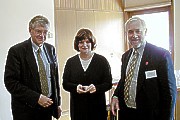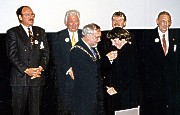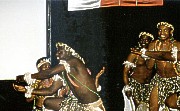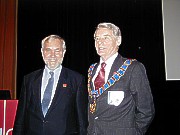Review of the UK Administration of FIG, 1995–1999
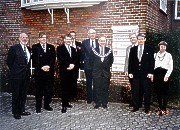 |
On 25 October 1995 the President of The Royal Institution of
Chartered Surveyors hosted a reception in London at which the
administration of FIG formally passed from Australia to the UK and
Professor Peter Dale took over from Earl James as President of the
Federation.
“Developing the profession in a developing world” was the theme
that underpinned the UK Bureau’s work.
Throughout its period of office the Bureau focused on |
- the surveyor’s response to social, economic, technological and
environmental change and
- took a particular interest in countries in economic transition and
in those with a low GNP.
The Bureau also recognised that markets for surveyors’ services are
constantly changing: emphasis was accordingly placed on
- strengthening professional institutions,
- promoting professional development and
- encouraging surveyors to acquire the new skills and techniques that
will properly equip them to meet the needs of society and the
environment.
This report summarises the work undertaken in furtherance of specific
elements of the Bureau’s work plan, of which highlights included:
- the establishment of an FIG office, to provide the continuity of
administration that will underpin FIG’s work in the 21st century
- giving FIG a modern, streamlined constitution
- co-operation with United Nations agencies, culminating in published
programmes of FIG/UN/World Bank co-operation for the period 2000–2003
and joint project activity with international organisations involved in
the management of land, property and construction
- expanding the membership base and improving services to all
categories of the membership
- improving FIG’s financial structure.
FIG Office
In May 1995 the Permanent Committee accepted in principle that, if FIG
was to continue to function effectively, it needed to move on from the
system of relying on a chief executive working voluntary and an
administration which moved to a different country every four years. One of
the first tasks of the UK Bureau was therefore to investigate the
feasibility, including the cost, of establishing a permanent office.
From a short-list of five potential locations the Permanent Committee
selected the headquarters of Den danske Landinspektorførening DdL (the
Danish member of FIG) in Copenhagen. The UK Bureau, working in close
collaboration with the incoming Bureau and with DdL, then established the
frameworks within which the office would operate and be staffed. Following
an international selection process, the post of office Director was
offered to Markku Villikka, at that time Director of Planning for the
Municipality of Hollola in Finland and immediate past chair of FIG
Commission 8. He took up his post on 1 January 1999 and the office was
officially opened in conjunction with a Bureau meeting held there on 3–4
February 1999. Its creation is probably the greatest challenge FIG has
undertaken in its 120 year history; but the office is more than meeting
the challenge in providing a complete range of support services, both
administrative and financial, for FIG and hence for the world-wide
surveying community. Great credit is due to Markku Villikka for having
established the office and its international reputation so securely and so
speedily; and to DdL and the wider surveying community in Denmark for the
support which they have given and continue to give to this land-mark
venture.
Statutes and Internal Rules
Recognising the need for a simplified constitution for FIG the UK
Bureau commissioned a major revision of the existing Statutes. The
resultant draft, comprising simplified Statutes and supporting Internal
Rules, definitions of responsibilities and guidance notes, was submitted
to an extensive consultation process prior to being approved by the
General Assembly in 1998. Major changes include
- a streamlined administrative structure (a single governing body, the
General Assembly, combining the functions of the previous General
Assembly and Permanent Committee and meeting annually)
- the introduction of the FIG working week (combining administrative
and commission meetings with focused technical seminars) in each of the
three years between congresses
- no restriction on the number of national associations from any one
country that can join FIG as member associations and the creation of two
new membership categories – affiliates and academic members
- a revised subscription structure
- a broadening of the rules to enable commissions, as well as member
associations, to nominate candidates for election as their chairs and
vice-chairs
- the introduction of English as FIG’s formal working language (as
agreed by the Permanent Committee in 1995 but without prejudice to
documents, including abstracts of papers presented at technical
meetings, being translated into other languages).
The complete document was published in September 1998 as FIG
publication no. 18 and posted on FIG’s home page.
The Future Governance and Management of FIG
The establishment of the FIG Office and the review of FIG’s
constitution both suggested that FIG should consider making more
fundamental changes to its management and operational structures if it was
to function as a truly international NGO and meet the challenges of the
21st century. The UK Bureau therefore established a task force to examine
possible options and report back during the period of the US
administration.
FIG/UN co-operation
This increased significantly during the period of the UK administration
– partly because the Bureau was able to build on contacts established by
its predecessors but also because the United Nations is increasingly
involving non-governmental organisations (NGOs) and professional
organisations in the preparation and execution of projects. To help manage
the rapidly increasing scope and pace of FIG’s interaction with UN
agencies, Ian Williamson was appointed Director, FIG/UN liaison in 1998.
In this role he has helped to take forward projects initiated during the
UK administration and he will subsequently advise the incoming Bureau and
the FIG Director on other possible ways of furthering FIG/UN links.
In March 1996 FIG, with the support of the UN and of the Australian and
Indonesian governments, organised an international meeting of cadastral
experts in Bogor, Indonesia. The result was the Bogor Declaration, setting
out desirable requirements and options for cadastral systems of developing
countries and countries in economic transition.
Ian Williamson, then chair of Commission 7 and who had acted as
technical co-ordinator of the Bogor meeting, represented FIG and presented
papers on the Bogor Declaration and on the strategic management of
cadastral reform at the two UN regional cartographic conferences that took
place in 1997 – the Asia/Pacific conference in Bangkok in February and the
Americas conference in New York in June. Both sets of resolutions clearly
demonstrated that, in the view of the UN, good land management policies
lie at the heart of sustainable economic growth and environmental
management; and it was clear that the UN attached great importance to
FIG’s on-going involvement in the development of such policies.
In January 1996 FIG participated in a meeting in New Delhi on access to
land and security of tenure – one of the topics included in the Global
Plan of Action to be adopted by the forthcoming HABITAT II Conference. The
President of FIG was subsequently co-opted on to the steering committee
dealing with NGO contributions to HABITAT II and invited to organise and
chair the one-day seminar, “Dialogue 6 – land and rural/urban linkages in
the 21st century”, that formed part of the HABITAT II programme.
HABITAT II, organised in Istanbul in June 1996 by the UN Centre for
Human Settlements (UNCHS/Habitat), was a follow up to the Earth Summit in
Rio 1992 which launched Agenda 21, the UN’s agenda for the 21st century.
Surveyors’ contributions are vital to the success of many of the issues
raised in Agenda 21 and the Global Plan of Action: in 1998 the Bureau
therefore established a task force on sustainable development to assist
FIG members to respond positively to both these important documents.
In January 1997 FIG signed a memorandum of understanding with
UNCHS(Habitat), whereby both organisations would undertake collaborative
projects in support of the Global Plan of Action and bring surveyors’
skills to bear on problems of human settlement, particularly in emerging
economies. Activity in furtherance of the memorandum included
contributions to the iKUSASA conference on land tenure and informal
settlements held in Durban in August and a workshop on land tenure in West
African francophone countries. Although FIG was prevented at the last
minute from attending this workshop, its organisation nevertheless gave
added impetus to the organisation of a Groupe Francophone of FIG’s
French-speaking members which held its inaugural meeting during the
Brighton congress.
The FIG/UNCHS(Habitat) memorandum was evaluated and extended during a
visit to the UNCHS headquarters by FIG representatives, including the
President-elect, the Director of FIG/UN liaison and the Director of the
FIG Office, in May 1999. Amongst other initiatives, the extension
formalised UNCHS’s commitment to the global workshop on land tenure and
cadastral infrastructures to support sustainable development held in
Bathurst, Australia, in October 1999. The genesis of this meeting between
FIG and UN international and regional agencies concerned with land
management and sustainable development was the 1996 Bogor conference which
had recognised that a clearer definition was needed of the rights,
responsibilities and obligations which attach to land.
 |
Dr. Sylvie Lacroux, UNCHS(Habitat) together with
Robert W. Foster and Prof. Ian Williamson at the UN/FIG Melbourne
Conference. |
The 1999 workshop resulted in “The Bathurst Declaration on Land Tenure
and Cadastral Infrastructures for Sustainable Development” (FIG
publication no. 22) which was formally presented to an immediately
following three-day conference in Melbourne sponsored by the UN, the New
South Wales and Victoria governments and the University of Melbourne’s
Department of Geomatics. The conference focused on the legal, technical
and institutional infrastructures that will be needed to support man/land
relationships for the next millennium in the context of Agenda 21 and the
Global Plan of Action.
Immediately following the conference, the senior officials from the
seven UN agencies and the World Bank who had attended both that event and
the Bathurst workshop took part in a round table with the President and
other representatives of FIG. The discussions and outcomes of the round
table are reported in “Co-operation between FIG and UN agencies,
2000–2003” (FIG publication no. 21).
The FIG Director attended the 17th Session of the Commission on Human
Settlements in Nairobi in May 1999, the first time FIG had taken part in
such a meeting as a UNCHS professional partner. He was invited to be one
of the panellists at a round table on housing rights and security of
tenure and was elected to the steering committee of the newly-formed
Habitat Professionals’ Forum. One of the most important issues discussed
at the bi-annual meeting was UNCHS (Habitat)’s future work programme,
comprising global campaigns for secure tenure and on good urban
governance. FIG’s input to both campaigns, and to the special session of
the UN General Assembly, “Istanbul+5” in June 2001, will be addressed in
an FIG/UNCHS plan of action for 2000–2001 to be signed when the present
memorandum of understanding expires at the end of 1999. The possibility of
involving the UN Environmental Programme in this new plan of action was
also pursued during the FIG Director’s visit to Nairobi.
Co-operation with other international organisations
The Dialogue which FIG organised as part of the HABITAT II programme
was sponsored by the International Real Estate Federation (FIABCI).
Working together on this event convinced both organisations that their
common interests in land and property provided plenty of opportunities for
networking; and they therefore signed and a joint memorandum of
understanding in 1997. Since then FIG has signed similar MoUs with the
International Cost Engineering Council (ICEC) and the International
Council for Research and Innovation in Building and Construction (CIB).
By the beginning of 1999 the Bureau had reluctantly decided that FIG
derived insufficient value from its membership of the International Union
of Surveys and Mapping (IUSM) to warrant the subscription payments.
However, following FIG’s formal resignation, IUSM itself was disbanded.
Options for maintaining links with its remaining members, following their
agreement to establish a new Joint Board, will be reviewed by the incoming
Bureau.
Work within the World Trade Organisation (WTO) to liberalise trade in
services led the UK Bureau to commission a review of surveying occupations
and activities and the way these are currently defined within the two main
UN international classifications. Suggestions for improvements to both
classifications, when they are next up-dated, have been discussed with the
responsible officers in the UN Statistical Department and the ILO. An FIG
task force on mutual recognition of qualifications was also established,
to review existing qualifications within the world-wide surveying
community, develop a framework for the introduction of guidelines of
global professional competence for surveyors and interact on FIG’s behalf
with the WTO.
Throughout the period of the UK administration FIG has been involved in
the work of the International Standards Organisation (ISO) as this relates
to geomatics and geographical information. An FIG task force on standards
was established to manage FIG input to ISO and to prioritise all necessary
FIG involvement in other standards activity.
Commission activity
The review does not detail the work of the FIG commissions, whose
operating cycle runs from congress to congress. Their activities over the
period 1994–1998 were published and circulated with the 1998 FIG Annual
Review and similar reports will be published for the period that will
conclude with the 2002 congress. It is, however, to mention two
initiatives. The first is the work of the Advisory Committee of Commission
Officers (ACCO), comprising chairs and vice-chairs of commissions, whose
meetings are now a regular – and important – feature of FIG working weeks.
Its importance as a source of ideas and support was well demonstrated by
the additional special meeting which was organised between ACCO and
members of the UK and incoming US Bureau in January 1998, to co-ordinate
the preparation of commission work plans for the period 1998–2002 and
develop a strategic plan for FIG.
The second initiative was the establishment of an ad hoc commission on
construction economics – an activity which forms part of the FIG
definition of a surveyor but which was not included within the remit of
any of the existing commissions.
Commission chairs for 1994–1998:
- Commission 1: Ken Allred
- Commission 2: Professor Stig Enemark
- Commission 3: Helge Onsrud
- Commission 4: Dr Wilfried Schleider
- Commission 5: Larry D Hothem
- Commission 6: Professor Chen Yongqi
- Commission 7: Professor Ian Williamson
- Commission 8: Markku Villikka
- Commission 9: Professor Brian Waldy
Permanent Institutions
The International Institution on the History of Surveying and
Measurement – a permanent institution of FIG – was established in 1998 to
continue the work of the former ad hoc commission on the history of
surveying. Its art and history of surveying exhibition and symposium were
popular and well-attended adjuncts to the 1998 FIG congress. One of its
more important current projects is its work with UNESCO to get the 19th
century Struve arc preserved as an international heritage monument.
The Office International du Cadastre et du Régime Foncier (OICRF) has
continued its work and in 1997 published a marketing plan for the 21st
century. The FIG Multi-Lingual Dictionary Board up-dated and published 10
of the 15 volumes that make up the 197l edition of this dictionary; its
work also continues. Because the FIG office took over responsibility for
the FIG archives, that permanent institution was wound up.
Membership
There were no substantial increases in the number of FIG’s member
associations during the period 1996-1999; but significant changes were
made to the membership structure. The first change opens membership of FIG
to any association, be it representative of one or all of the disciplines
of surveying, whose members possess relevant academic and professional
qualifications and provide professional services in accordance with
ethical standards. The category of affiliate member – defined in the new
Statutes and Internal Rules as “an organisation comprised of individuals
who practise the profession of surveying but which does not fulfil the
criteria for membership as a membership association” – enables FIG to work
with such organisations and thereby assist professional development in
their respective countries. The category of academic member was created in
recognition of the contribution which teaching and research institutions
make to the development of the profession. The fact that 15 university
departments have joined FIG in the five months since this category of
membership is indicative of the value which the academic community
attaches to FIG. The Academic members of FIG at the end of 1999 were:
- The University of Melbourne, Australia
- University of Botswana
- University of New Brunswick, Canada
- Universidad Distrital Francisco José de Caldas de Bogotá, Colombia
- Aalborg University, School of Surveying, Denmark
- Helsinki University of Technology, Finland
- Technische Universität München, Germany
- The Hong Kong Polytechnic University, Hong Kong, China
- Dublin Institute of Technology, Ireland
- University of Otago, New Zealand
- University “Dunarea de Jos” din Calati, Romania
- Royal Institute of Technology, Sweden
- Leeds Metropolitan University, United Kingdom
- Sheffield Hallam University, United Kingdom
- University College London, United Kingdom.
The following appointments were made at FIG’s General Assemblies in
1998 and 1999:
- as Honorary Presidents of FIG: Earl James (President during the
Australian administration) and, posthumously, Colonel Wladislaw Surmacki
(President-elect when FIG was forced to suspend its activities at the
outbreak of the second world war)
- as Honorary Members: Clifford Dann (UK), Pekka Raitanen (Finland),
John Curdie (Australia), Ernst Höflinger (Austria), Taichi Oshima
(Japan), Georgi Milev (Bulgaria), Stig Enemark (Denmark) and Jane
Woolley (UK).
At the conclusion of the UK administration of FIG the membership
consisted of:
- 76 member associations in 66 countries
- 4 affiliate members
- 9 sponsor members
- 16 correspondents
- 7 Honorary Presidents
- 29 Honorary Members.
Membership Support
Stemming from a suggestion that FIG should do more to support the role
of women in surveying, in 1997 the UK Bureau established a task force on
under-represented groups in surveying to encourage greater participation
in professional activity by women, young surveyors and other
under-represented groups.
To help surveyors meet the needs of the markets and the communities
that they serve the UK Bureau commissioned four FIG publications:
“Continuing Professional Development” (no. 15), “Constituting Professional
Associations” (no. 16); “FIG Statement of Ethical Principles and Model
Code of Professional Conduct” (no. 17); and “Quality Assurance in
Surveying Education” (no. 19).
A practical example of how FIG can assist professional development is
the influence which the Bureau and the then chair of Commission 2 brought
to bear, at the request of FIG’s member association in Sri Lanka, on that
country’s government, resulting in the establishment in 1998 of a first
degree course in surveying at the University of Sabaragamuwa.
The President and other members of the UK Bureau have managed to visit
most member associations – either en route to and from FIG meetings or in
conjunction with their own business travel. To encourage the member
associations to become more involved in FIG’s decision-making processes
the President of FIG organised an informal meeting during the 1998
congress with the Presidents or their representatives of more than 40
member associations. This was judged a great success and a similar meeting
was therefore arranged during the 1999 working week.
Also in 1998 and 1999 Bureau members held several meetings with FIG’s
sponsor members. Sponsors make an important contribution to the work and
development of FIG and it is therefore important that they derive maximum
benefit from their membership of the Federation. Berntsen International
Inc and Kampsax
A/S joined FIG as sponsor members in 1995–1999.
Other Communications
The new quarterly FIG Bulletin was introduced by the UK Bureau, using a
format which encourages member associations to abstract information to
pass on to their individual members via their own journals. The Bulletin
is produced as a published document; since the beginning of this year it
has also been placed on FIG’s home page.
Another new venture was the FIG Annual Review, a 12-page high quality
publication containing a brief resumé of the year’s events and directed
mainly at clients of surveyors’ services. Two information leaflets and
three FIG publications, in addition to those already mentioned, were
published by the UK Bureau: FIG’s Plan of Work 1996–1999 (no. 12); “Land
Tenure, Land Management and Land Information Systems” (no. 13) – the
report of FIG/UN round table meetings in August 1995; and “Working Towards
Liberalisation in Trade in Services” (no. 14). The popularity of the FIG
Statement on the Cadastre, prepared by Commission 7 and published by the
Australian Bureau as FIG publication no. 11, is evinced by its translation
to date, mainly by member associations, into a total of 20 languages; and
similar best-seller status is predicted for Commission 7’s companion
publication on reforming the cadastre, “Cadastre 2014”.
The proceedings of several of the seminars organised by FIG’s
commissions were also published and most of the commissions now produce
their own newsletters.
It is electronic media that have facilitated the most important
development in FIG communications, particularly since the establishment of
the FIG office. An FIG home page has been established: news flashes, press
releases, the quarterly FIG Bulletin, meetings information and all
administrative documents are now placed on the home page as well as being
delivered by post. Linkages have also been set up between the FIG home
page and those of the commissions, the members and allied professional
bodies.
Meetings
FIG working weeks were held in Argentina in April 1996, Singapore in
May 1997 and South Africa in May/June 1999. In 1998 administrative
meetings were combined with the XXI International Congress of Surveyors,
hosted by The Royal Institution of Chartered Surveyors in Brighton, UK in
July and providing more than 1,000 delegates and their guests from 80
countries with their best-ever opportunity for global networking, with
each other and with an equal number of day delegates and visitors to the
largest exhibition ever to have been staged as part of an FIG congress.
Care was taken to cite the exhibition at the very centre of the Congress
venue – a facility welcomed by exhibitors and visitors alike. The
commission sessions were complemented by three open forums which brought
surveyors of all disciplines together to discuss the impact of technology,
sustainable infrastructures and the global property market with
acknowledged experts in these three fields. Another notable success of the
congress was the sponsorship, by FIG and others, of young professionals
from eastern Europe, some of whom were meeting surveyors from outside
their own country for the first time.
A detailed account of the congress and copies of the presented papers
are contained in the 10 volumes of the published proceedings.
Most of the commissions organised meetings additional to their congress
sessions and the seminars which they ran during FIG working weeks.
Commission 7 has established the practice of holding an annual meeting and
accompanying seminar and Commission 3 is moving towards doing the same.
Commission 2 runs a mid-term workshop and seminar, inter alia to
facilitate the development of the incoming chair’s work plan; Commissions
5 and 6 tend to organise their workshops and symposia jointly with allied
scientific organisations; in 1997 they also joined with Commission 4 in
running a symposium in Denmark.
Finance
Moving FIG’s administration from country to country every four years
meant that each Bureau started work from a zero financial base. This,
coupled with the need to increase subscription income to meet the cost of
an ever-increasing work load, led to the establishment of a task force to
review FIG’s financial structure. As well as recognising that the FIG
office will provide some much needed continuity in the management of FIG’s
finances the task force made several recommendations for augmenting
subscription income. The resultant regular, albeit modest, annual
increases in rates, coupled with the introduction in 1998 of a sliding
scale of maximum subscriptions payable by associations with more than
4,000 members, are expected to keep income and expenditure in balance for
the foreseeable future.
The UK Bureau increased the amounts of annual grants paid to the
commissions. and instituted a system of accounting for commission grants,
partly to identify the support which commission chairs receive from other
sources and the funds which they personally commit to their work for FIG.
FIG Education Foundation
The Foundation, established by the Australian administration of FIG,
continued its fund-raising activities and at the end of its 1999
accounting year held total assets of $27,790.55. It has established
policies for the distribution of funds, which will start once the
principle balance reaches $100,000.
Acknowledgements
The UK Bureau cannot conclude this review without acknowledging the
debt which FIG owes to so many organisations and individuals. On-going
thanks are due to DdL for its support of the FIG office. The RICS
underpinned the work of the UK Bureau before and throughout its period of
office; ran a highly successful FIG congress; and supported both the
establishment of the FIG office and FIG’s work with other international
organisations. Nearly all member associations and many governments
assisted delegates to participate in FIG business and sponsored FIG
meetings. Commission officers, task force chairs, directors of permanent
institutions, national and commission delegates, and a host of other
individuals gave unstintingly of their time; and their contributions to
the work of FIG was often at their own expense.
FIG could not function without the dedicated support of so many people
throughout the world. This dedication, coupled with the continuity of
administration that will be provided by the FIG office, will stand the
Federation in good stead as it moves into the next century.
|




























